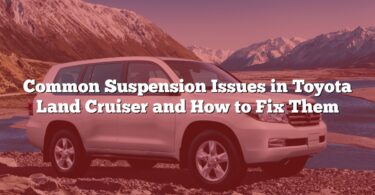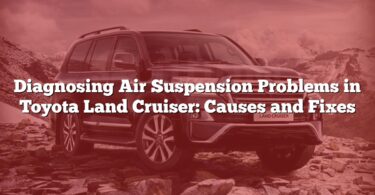Alternator issues can disrupt the performance of your Toyota Land Cruiser, leaving you stranded or dealing with costly repairs. Understanding the most common causes and their solutions is essential for maintaining your vehicle’s reliability. In this guide, we’ll explore 31 potential alternator problems, their warning signs, and step-by-step solutions to help you get back on the road with confidence.
How to Fix Alternator Problems in a Toyota Land Cruiser: 31 Common Causes and Their Solutions
| N° | Problem/Cause | Solution |
|---|---|---|
| 1 | Worn-out alternator belt | Replace the belt. |
| 2 | Loose or broken alternator belt | Tighten or replace the belt. |
| 3 | Faulty alternator bearings | Replace the bearings or the alternator assembly. |
| 4 | Damaged alternator pulley | Replace the pulley. |
| 5 | Worn-out brushes in the alternator | Replace the brushes. |
| 6 | Defective voltage regulator | Replace the voltage regulator. |
| 7 | Corroded or loose electrical connections | Clean, tighten, or replace the connections. |
| 8 | Faulty alternator diode | Replace the diode or the alternator assembly. |
| 9 | Internal alternator failure | Replace the alternator. |
| 10 | Overheated alternator | Address the cause, such as excessive load or poor ventilation, or replace the alternator. |
| 11 | Battery-related issues affecting alternator function | Test and replace the battery if necessary. |
| 12 | Short circuit in the alternator wiring | Repair or replace the damaged wiring. |
| 13 | Faulty ground connections | Tighten or repair ground connections. |
| 14 | Excessive electrical load on the alternator | Reduce accessory usage or upgrade to a high-capacity alternator. |
| 15 | Water damage or contamination in the alternator | Dry or replace the alternator. |
| 16 | Faulty alternator rotor or stator | Replace the rotor or stator. |
| 17 | Excessive belt tension causing strain on the alternator | Adjust the belt tension to proper specifications. |
| 18 | Alternator misalignment | Realign the alternator and check mounting points. |
| 19 | Damaged or frayed wiring harness | Repair or replace the wiring harness. |
| 20 | Improper installation of the alternator | Reinstall the alternator correctly following proper guidelines. |
| 21 | Alternator not charging the battery | Inspect and replace faulty components or repair damaged wiring. |
| 22 | Unusual noise from the alternator (grinding or whining) | Inspect and replace damaged bearings or bushings. |
| 23 | Dim dashboard lights or headlights | Test and repair the alternator or replace the battery if necessary. |
| 24 | Weak or dead car battery | Charge or replace the battery, then test the alternator. |
| 25 | Burning rubber or electrical smell | Tighten the belt or replace slipping components. |
| 26 | Faulty alternator pulley replacement | Replace the pulley with a compatible one. |
| 27 | Alternator voltage output issues | Test and replace the voltage regulator or the alternator. |
| 28 | Cracked or worn belts connected to the alternator | Replace the belts. |
| 29 | Electrical connection failures between alternator and components | Clean, tighten, or replace the faulty connections. |
| 30 | Worn-out alternator bushings | Replace the bushings or the alternator. |
| 31 | Overloaded alternator due to accessory usage | Reduce electrical accessory usage or upgrade the alternator to a higher capacity model. |
Detailed Guide : Causes and Their Solutions
1. Worn-out Alternator Belt
Reason:
- The belt has deteriorated due to age or wear and tear.
- It is no longer providing the necessary tension for the alternator to function effectively.
Solution:
Replace the worn-out belt with a new one that matches the manufacturer’s specifications. Ensure proper tension is applied during installation.
2. Loose or Broken Alternator Belt
Reason:
- The belt has loosened due to prolonged use.
- It may have broken due to excessive strain or misalignment.
Solution:
Inspect the belt and tighten it if it is loose. If broken, replace the belt and adjust the tension to avoid slippage.
3. Faulty Alternator Bearings
Reason:
- Bearings inside the alternator are worn or damaged due to friction or lack of lubrication.
Solution:
Replace the faulty bearings. If the damage is extensive, replace the entire alternator assembly.
4. Damaged Alternator Pulley
Reason:
- The pulley is cracked, bent, or has worn grooves.
Solution:
Replace the damaged pulley with a new one that fits your alternator model.
5. Worn-out Brushes in the Alternator
Reason:
- The brushes, which transfer electrical current, are worn due to prolonged use.
Solution:
Disassemble the alternator and replace the worn brushes with new ones. Ensure proper alignment during reassembly.
6. Defective Voltage Regulator
Reason:
- The voltage regulator fails to maintain a steady voltage output.
Solution:
Replace the defective voltage regulator. Test the new regulator to confirm proper voltage levels.
7. Corroded or Loose Electrical Connections
Reason:
- Connections have corroded due to moisture or poor maintenance.
- Loose connections disrupt electrical flow.
Solution:
Clean the connections using a wire brush or contact cleaner. Tighten or replace any loose or damaged connectors.
8. Faulty Alternator Diode
Reason:
- A diode in the alternator’s rectifier has failed, causing electrical leakage or improper current flow.
Solution:
Replace the faulty diode or, if necessary, the entire rectifier.
9. Internal Alternator Failure
Reason:
- Internal components like the stator or rotor are damaged or worn out.
Solution:
Replace the alternator entirely as internal repairs can be labor-intensive and costly.
10. Overheated Alternator
Reason:
- Excessive electrical load or poor ventilation leads to overheating.
Solution:
Reduce electrical load by turning off non-essential accessories. Check for obstructions around the alternator and clear them. If damage is already done, replace the alternator.
11. Battery-Related Issues Affecting Alternator Function
Reason:
- A weak or failing battery places extra strain on the alternator.
Solution:
Test the battery using a multimeter. Replace it if it is weak or dead to ensure proper alternator function.
12. Short Circuit in the Alternator Wiring
Reason:
- Damaged wiring causes a short circuit, disrupting power flow.
Solution:
Inspect the wiring harness for damage. Repair or replace the affected wires.
13. Faulty Ground Connections
Reason:
- Ground connections are loose or corroded, leading to poor electrical conductivity.
Solution:
Tighten or replace ground connections. Clean corroded areas to ensure a solid connection.
14. Excessive Electrical Load on the Alternator
Reason:
- Too many electrical accessories are drawing power, overloading the alternator.
Solution:
Reduce usage of non-essential accessories. Consider upgrading to a high-capacity alternator if additional power is needed.
15. Water Damage or Contamination in the Alternator
Reason:
- Water or debris has entered the alternator, causing electrical malfunctions.
Solution:
Dry the alternator thoroughly. If damage is significant, replace the alternator.
16. Faulty Alternator Rotor or Stator
Reason:
- The rotor or stator inside the alternator is damaged or worn.
Solution:
Replace the damaged rotor or stator. Test the alternator for proper functionality after repair.
17. Excessive Belt Tension Causing Strain on the Alternator
Reason:
- The belt tension is too high, putting undue stress on the alternator bearings and pulley.
Solution:
Adjust the belt tension to the manufacturer’s specifications using a tension gauge.
18. Alternator Misalignment
Reason:
- The alternator is not aligned properly with the belt system.
Solution:
Realign the alternator and inspect mounting brackets for wear or damage.
19. Damaged or Frayed Wiring Harness
Reason:
- Wiring harness is damaged, leading to electrical disruptions.
Solution:
Repair or replace the wiring harness to restore proper electrical flow.
20. Improper Installation of the Alternator
Reason:
- Incorrect installation leads to alignment or connection issues.
Solution:
Reinstall the alternator correctly. Follow the manufacturer’s guidelines for proper installation.
21. Alternator Not Charging the Battery
Reason:
- Faulty components or wiring prevent proper charging.
Solution:
Inspect and replace any damaged wiring or components in the charging system.
22. Unusual Noise from the Alternator (Grinding or Whining)
Reason:
- Bearings or bushings are worn out.
Solution:
Replace the worn bearings or bushings. If noise persists, inspect other internal components.
23. Dim Dashboard Lights or Headlights
Reason:
- Alternator output is insufficient for the electrical load.
Solution:
Test the alternator and repair or replace it if necessary. Also, check the battery for issues.
24. Weak or Dead Car Battery
Reason:
- The battery cannot hold a charge, affecting alternator performance.
Solution:
Charge or replace the battery. Test the alternator to ensure it is functioning properly.
25. Burning Rubber or Electrical Smell
Reason:
- The belt is slipping or components are overheating.
Solution:
Tighten or replace the belt. Check for overheating and address any underlying issues.
26. Faulty Alternator Pulley Replacement
Reason:
- A damaged or incorrect pulley causes alternator malfunction.
Solution:
Replace the pulley with a compatible one designed for your alternator.
27. Alternator Voltage Output Issues
Reason:
- Voltage output is inconsistent due to regulator failure or internal alternator issues.
Solution:
Replace the voltage regulator or the alternator as needed.
28. Cracked or Worn Belts Connected to the Alternator
Reason:
- Belts are cracked or worn out, reducing efficiency.
Solution:
Replace the damaged belts and ensure proper tension.
29. Electrical Connection Failures Between Alternator and Components
Reason:
- Loose or damaged connections disrupt electrical flow.
Solution:
Clean, tighten, or replace the faulty connections.
30. Worn-out Alternator Bushings
Reason:
- Bushings have deteriorated due to age or strain.
Solution:
Replace the bushings or the entire alternator assembly.
31. Overloaded Alternator Due to Accessory Usage
Reason:
- Excessive use of accessories strains the alternator.
Solution:
Limit accessory usage or upgrade to a higher-capacity alternator to handle the load.
Preventing Future Issues
To ensure your Toyota Land Cruiser’s alternator operates reliably and to prevent future problems, follow these steps:
- Perform Regular Inspections
- Check the alternator belt for signs of wear, cracks, or looseness.
- Inspect the electrical connections for corrosion or looseness.
- Look for any visible damage to the alternator or surrounding components.
- Maintain Proper Belt Tension
- Use a belt tension gauge to ensure the belt is not too loose or overly tight.
- Adjust the tension according to the manufacturer’s specifications.
- Keep Electrical Load Balanced
- Avoid overloading the alternator with excessive accessory usage.
- Turn off non-essential electronics, especially when idling or driving at low RPMs.
- Protect the Alternator from Water and Contaminants
- Avoid driving through deep water that can splash onto the alternator.
- Keep the engine bay clean to prevent dirt and debris from accumulating.
- Replace Worn Components Promptly
- Replace the alternator belt, brushes, and bushings as soon as signs of wear appear.
- Do not delay repairs if you notice symptoms like dim lights, unusual noises, or smells.
- Test the Battery and Charging System Regularly
- Use a multimeter or visit a mechanic to test the battery and alternator voltage output periodically.
- Ensure the battery is in good condition, as a failing battery can stress the alternator.
- Follow Scheduled Maintenance
- Adhere to the vehicle’s recommended maintenance schedule for inspecting and servicing the electrical system.
- Keep detailed records of repairs and replacements.
- Address Warning Signs Immediately
- If the dashboard warning light for the alternator activates, investigate and resolve the issue promptly.
- Ignoring early warning signs can lead to costly repairs or breakdowns.
By following these preventive measures, you can extend the life of your alternator, reduce unexpected failures, and ensure your vehicle remains in optimal working condition.







